BGP Questions 2
Question 1
Which attribute is not part of the BGP extended community when a PE creates a VPN-IPv4 route while running OSPF between PE-CE?
A. OSPF domain identifier
B. OSPF route type
C. OSPF router ID
D. MED
E. OSPF network type
B. OSPF route type
C. OSPF router ID
D. MED
E. OSPF network type
Answer: E
Question 2
Refer to the exhibit.
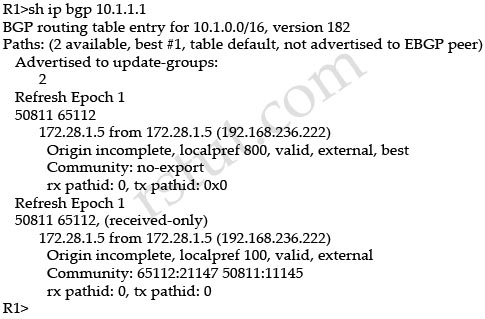
What does “(received-only)” mean?
A. The prefix 10.1.1.1 can not be advertised to any eBGP neighbor.
B. The prefix 10.1.1.1 can not be advertised to any iBGP neighbor.
C. BGP soft reconfiguration outbound is applied.
D. BGP soft reconfiguration inbound is applied.
B. The prefix 10.1.1.1 can not be advertised to any iBGP neighbor.
C. BGP soft reconfiguration outbound is applied.
D. BGP soft reconfiguration inbound is applied.
Answer: D
Question 3
Which statement describes the BGP add-path feature?
A. It allows for installing multiple IBGP and EBGP routes in the routing table.
B. It allows a network engineer to override the selected BGP path with an additional path created in the config.
C. It allows BGP to provide backup paths to the routing table for quicker convergence.
D. It allows multiple paths for the same prefix to be advertised.
B. It allows a network engineer to override the selected BGP path with an additional path created in the config.
C. It allows BGP to provide backup paths to the routing table for quicker convergence.
D. It allows multiple paths for the same prefix to be advertised.
Answer: D
Question 4
Refer to the exhibit.
| *>172.21.95.0/22 172.17.192.1 0 120 0 65534 65535 65100 65235 ? |
For which reason could a BGP-speaking device in autonomous system 65534 be prevented from installing the given route in its BGP table?
A. The AS number of the BGP is specified in the given AS_PATH.
B. The origin of the given route is unknown.
C. BGP is designed only for publicly routed addresses.
D. The AS_PATH for the specified prefix exceeds the maximum number of ASs allowed.
E. BGP does not allow the AS number 65535.
B. The origin of the given route is unknown.
C. BGP is designed only for publicly routed addresses.
D. The AS_PATH for the specified prefix exceeds the maximum number of ASs allowed.
E. BGP does not allow the AS number 65535.
Answer: A
Question 5
Which statement about the BGP originator ID is true?
A. The route reflector always sets the originator ID to its own router ID.
B. The route reflector sets the originator ID to the router ID of the route reflector client that injects the route into the AS.
C. The route reflector client that injects the route into the AS sets the originator ID to its own router ID.
D. The originator ID is set to match the cluster ID.
B. The route reflector sets the originator ID to the router ID of the route reflector client that injects the route into the AS.
C. The route reflector client that injects the route into the AS sets the originator ID to its own router ID.
D. The originator ID is set to match the cluster ID.
Answer: B
Question 6
Refer to the exhibit.
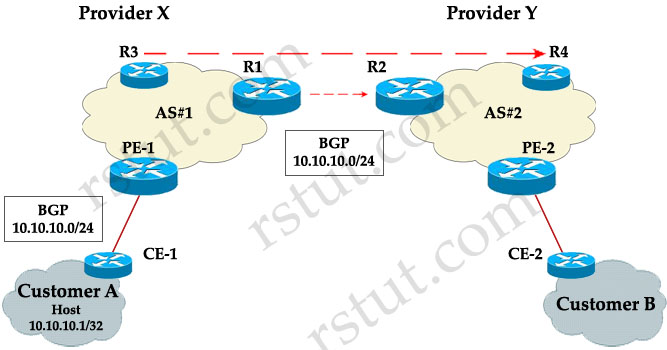
AS#1 and AS#2 have multiple EBGP connections with each other. AS#1 wants all return traffic that is destined to the prefix 10.10.10.1/32 to enter through the router R1 from AS#2. In order to achieve this routing policy, the AS 1 advertises a lower MED from R1, compared to a higher MED from R3, to their respective BGP neighbor for the prefix 10.10.10.0/24. Will this measure guarantee that the routing policy is always in effect?
AS #1 and AS #2 have multiple EBGP connections with each other. AS #1 wants all return traffic that is destined to the prefix 10.10.10.1/32 to enter through the router R1 from AS #2. In order to achieve this routing policy, the AS#1 advertises a lower MED from R1, compared to a higher MED from R3, to their respective BGP neighbor for the prefix 10.10.10.0/24. Will this measure guarantee that the routing policy is always in effect?
AS #1 and AS #2 have multiple EBGP connections with each other. AS #1 wants all return traffic that is destined to the prefix 10.10.10.1/32 to enter through the router R1 from AS #2. In order to achieve this routing policy, the AS#1 advertises a lower MED from R1, compared to a higher MED from R3, to their respective BGP neighbor for the prefix 10.10.10.0/24. Will this measure guarantee that the routing policy is always in effect?
A. Yes, because MED plays a deterministic role in return traffic engineering in BGP.
B. Yes, because a lower MED forces BGP best-path route selection in AS #2 to choose R1 as the best path for 10.10.10.0/24.
C. Yes, because a lower MED in AS #2 is the highest BGP attribute in BGP best-path route selection.
D. No, AS #2 can choose to alter the weight attribute in R2 for BGP neighbor R1, and this weight value is cascaded across AS #2 for BGP best-path route selection.
E. No, AS #2 can choose to alter the local preference attribute to overwrite the best-path route selection over the lower MED advertisement from AS #1. This local preference attribute is cascaded across AS #2 for the BGP best-path route selection.
B. Yes, because a lower MED forces BGP best-path route selection in AS #2 to choose R1 as the best path for 10.10.10.0/24.
C. Yes, because a lower MED in AS #2 is the highest BGP attribute in BGP best-path route selection.
D. No, AS #2 can choose to alter the weight attribute in R2 for BGP neighbor R1, and this weight value is cascaded across AS #2 for BGP best-path route selection.
E. No, AS #2 can choose to alter the local preference attribute to overwrite the best-path route selection over the lower MED advertisement from AS #1. This local preference attribute is cascaded across AS #2 for the BGP best-path route selection.
Answer: E
Question 7
Refer to the exhibit. All iBGP routes should have the iBGP peer as the next hop address. Why is this not the case for BGP routes learned between R1 and R2?
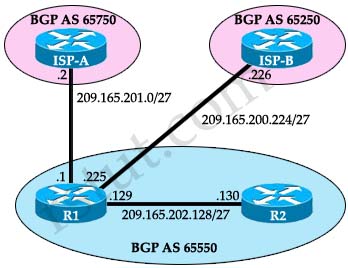
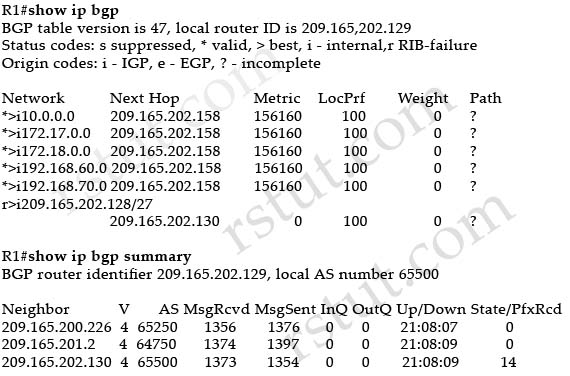
A. R2 is missing the next-hop-self option under the neighbor command for R1
B. ISP-A is missing the next-hop-self option under the neighbor command for R1
C. ISP-B is missing the next-hop-self option under the neighbor command for R1
D. R2, ISP-A, and ISP-B are missing the next-hop-self option under the neighbor command for R1
B. ISP-A is missing the next-hop-self option under the neighbor command for R1
C. ISP-B is missing the next-hop-self option under the neighbor command for R1
D. R2, ISP-A, and ISP-B are missing the next-hop-self option under the neighbor command for R1
Answer: A
Explanation
In this case networks 10.0.0.0, 172.17.0.0, 172.18.0.0, 192.168.60.0, 192.168.70.0 are networks learned and advertised from R2. We see that the next-hop of these networks are 209.165.202.158 while they should be 209.165.202.130. With the next-hop of 209.165.202.158, R1 may not know how to send traffic to above networks and the traffic is dropped. To avoid this failure we should configure the ‘next-hop-self’ under the neighbor command for R1 like this:
R2(config-router)#neighbor 209.165.202.129 next-hop-self
R2(config-router)#neighbor 209.165.202.129 next-hop-self
Question 8
Refer to the exhibit. By default, why will BGP choose a locally originated route over any iBGP or eBGP learned route?
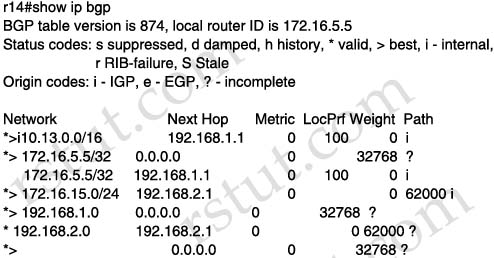
A. The IGP metric to the next hop is always shorter.
B. Locally originated routes have a better AD than eBGP or iBGP routes.
C. All locally originated routes have a better origin code.
D. Locally originated routes have a higher metric.
E. Locally originated routes have a weight of 32,768.
B. Locally originated routes have a better AD than eBGP or iBGP routes.
C. All locally originated routes have a better origin code.
D. Locally originated routes have a higher metric.
E. Locally originated routes have a weight of 32,768.
Answer: E
Question 9
Refer to the exhibit. The next hops are learned via OSPF and IS-IS. Which path is selected as the best path for 10.168.0.1?

A. path 1, because it is an MPLS labeled path
B. path 1, because the next hop is learned via OSPF with an AD of 110, compared to 115 for IS-IS
C. path 2, because it has the highest router ID
D. path 2, because it has the lowest IGP metric
B. path 1, because the next hop is learned via OSPF with an AD of 110, compared to 115 for IS-IS
C. path 2, because it has the highest router ID
D. path 2, because it has the lowest IGP metric
Answer: D
Question 10
Which set of commands conditionally advertises 172.16.0.0/24 as long as 10.10.10.10/32 is in the routing table?
A)
A)
| neighbor x.x.x.x advertise-map ADV exist-map EXT route-map ADV match ip address prefix-list ADV ! route-map EXT match ip address prefix-list EXT ! ip prefix-list EXT permit 172.16.0.0/24 ! ip prefix-list ADV permit 10.10.10.10/32 |
B)
| neighbor x.x.x.x advertise-map ADV exist-map EXT route-map ADV match ip address prefix-list ADV ! route-map EXT match ip address prefix-list EXT ! ip prefix-list ADV permit 172.16.0.0/24 ! ip prefix-list EXT permit 10.10.10.10/32 |
C)
| neighbor x.x.x.x advertise-map ADV route-map ADV match ip address prefix-list ADV match ip address prefix-list EXT ! ip prefix-list ADV permit 172.16.0.0/24 ! ip prefix-list EXT permit 10.10.10.10/32 |
D)
| neighbor x.x.x.x exist-map EXT route-map EXT match ip address prefix-list ADV match ip address prefix-list ADV match ip address prefix-list EXT ! ip prefix-list ADV permit 172.16.0.0/24 ! ip prefix-list EXT permit 10.10.10.10/32 |
A. Option A
B. Option B
C. Option C
D. Option D
B. Option B
C. Option C
D. Option D
Answer: B
Explanation
Advertise maps are used for conditional routing to advertise specified prefixes if something which is specified in exist map exists. In our question we need to advertise 172.16.0.0/24 if 10.10.10.10/32 exists in the routing table so we have to use command: “neighbor x.x.x.x advertise-map <prefix-list of 172.16.0.0/24> exist-map <prefix-list of 10.10.10.10/32>”. Therefore B is correct.
Sign up here with your email

ConversionConversion EmoticonEmoticon